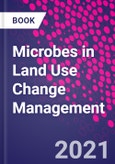Microbes in Land Use Change Management details the various roles of microbial resources in management of land uses and how the microbes can be used for the source of income due to their cultivation for the purpose of biomass and bioenergy production. Using various techniques, the disturbed and marginal lands may also be restored eco-friendly in present era to fulfil the feeding needs of mankind around the globe.
Microbes in Land Use Change Management provides standard and up to date information towards the land use change management using various microbial technologies to enhance the productivity of agriculture. Needless to say that Microbes in Land Use Change Management also considers the areas including generation of alternative energy sources, restoration of degraded and marginal lands, mitigation of global warming gases and next generation -omics technique�etc.
Land use change affects environment conditions and soil microbial community. Microbial population and its species diversity have influence in maintaining ecosystem balance. The study of changes of microbial population provides an idea about the variation occurring in a specific area and possibilities of restoration.
Meant for a multidisciplinary audience Microbes in Land Use Change Management shows the need of next-generation omics technologies to explore microbial diversity.
Please Note: This is an On Demand product, delivery may take up to 11 working days after payment has been received.
Table of Contents
1. Temperature sensitivity of litter and soil organic matter decomposition: perspective of soil microbial community structure and function�
2. Adaptation of bacterial communities and plant strategies for amelioration and eco-restoration of an organometallic industrial waste polluted site�
3. Effect of soil biofilms on ecological function and impact on soil properties�
4. Alteration in microbial population density composition in different land use systems�
5. Molecular characterization of bacterial community succession and analysis of physiochemical properties in a compost of solid organic waste from Gandhinagar, Gujarat, India�
6. Molecular technologies for the early detection of fungal phytopathogens associated with cereal crops�
7. Applicability of fungi in agriculture and environmental sustainability�
8. Litterfall decomposition of selected plant species and nutrient
cycling in Madhupur Sal (Shorea robusta Roth) forest of Bangladesh�
9. Bioactivity of soil microorganisms for agriculture development�
10. Next generation OMICS: a tool to understand the diversity of soil microbiota and improvement of agricultural sustainability�
11. Microbial associations in ecological reclamation and restoration of marginal lands�
12. Assessment of microbial biomass for production of ecofriendly
single-cell protein, bioenergy, and other useful products�
13. Participation and understanding of plant microbes' interaction in plant health and growth by combating mercury stress: a sustainable approach towards agricultural practices�
14. The role of plant growth promoting bacteria in mineralization of endosulfan and its metabolites�
15. Response of microbial populations to landscape dynamics�
16. Soil-plant-microbial interactions for soil fertility management and sustainable agriculture�
17. Endophytic microbial interaction with legume crop for developing resistance against nutrient stress�
18. Function-driven microbial genomics for ecofriendly agriculture�
19. Role of microbial communities in restoration disturbed lands�
20. Impact of microbial biofilm on crop productivity and agricultural sustainability�
21. Valuing each patch of land: utilizing plant-microbe interactions for the betterment of agriculture�
22. Tripartite interactions: plant-Pseudomonas putida-microRNAs in agricultural� productivity�
23. Next-generation omics technologies to explore microbial diversity�








